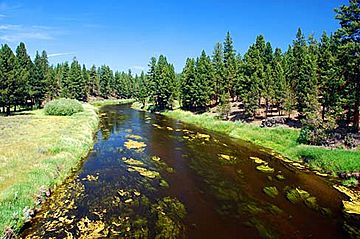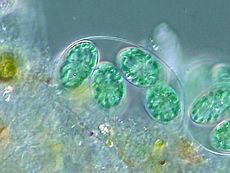Archaeplastida facts for kids
Quick facts for kids Archaeplastida |
|
|---|---|
 |
|
| Trees, grasses and algae in and around Sprague River, Oregon | |
| Scientific classification |
|
| Domain: | Eukaryota |
| (unranked): | Diaphoretickes |
| (unranked): | Archaeplastida Adl et al., 2005 |
| Subgroups | |
|
|
| Synonyms | |
|
|
The Archaeplastida are a large group of living things. They include red algae, green algae, and all land plants. A smaller group called glaucophytes is also part of Archaeplastida. These organisms are special because they can make their own food using sunlight. This process is called photosynthesis.
Archaeplastida have special parts inside their cells called chloroplasts. These chloroplasts are like tiny solar panels that capture sunlight. Scientists believe these chloroplasts came from a type of bacteria called cyanobacteria. This happened a very long time ago when an early Archaeplastida cell "ate" a cyanobacterium, and they started living together. This event is called primary endosymbiosis.
Most Archaeplastida cells have a cell wall made of cellulose. They also store food as starch. Their mitochondria, which are like the powerhouses of the cell, have flat folds inside.
Contents
Understanding Archaeplastida
Scientists study the genes of these organisms to understand how they are related. Most evidence suggests that all Archaeplastida came from a single ancestor. This means they form a single evolutionary group.
There are two main branches within Archaeplastida:
- Red Algae: These get their red color from special pigments. They store starch outside their chloroplasts.
- Green Algae and Land Plants: These are known as Viridiplantae. They have green pigments and store starch inside their chloroplasts.
- Glaucophytes: These are a small group. Their chloroplasts are unique because they still have a cell wall, much like the original cyanobacteria.
How Scientists Classify Archaeplastida
Scientists group living things to understand their relationships. In 2005, the name 'Archaeplastida' was given to the group including glaucophytes, red algae, green algae, and land plants. Most studies agree that this group is a true clade, meaning they all share a common ancestor.
Other names have been used for this group, like "Plantae" (plants). But "Plantae" can be confusing because it's also used for smaller groups, like just land plants. So, 'Archaeplastida' helps to be clear about this larger group.
Scientists use many clues to classify organisms. These clues include how they look, what chemicals they are made of, and their genetic information.
Archaeplastida includes:
- Glaucophyta (Glaucophytes):
- These are small, single-celled algae that live in freshwater.
- Their chloroplasts, called cyanelles, have a special layer like bacteria. This makes them very similar to the cyanobacteria they came from.
- Rhodophyceae (Red Algae):
- This is one of the largest groups of algae.
- Most red algae are seaweeds, meaning they are multicellular and live in the ocean.
- Their red color comes from special pigments that help them capture light for photosynthesis.

- Chloroplastida (Green Algae and Land Plants):
- This group includes all green algae and land plants.
- Their chloroplasts do not have the special bacterial layer found in glaucophytes.
- They also do not have the red pigments found in red algae.

Green Algae Subgroups
Green algae are a diverse group. Some important subgroups are:
- Chlorophyta (a large part of green algae)
- Chlorodendrales
- Prasinophytae
- Mesostigma
- Charophyta (includes some green algae and all land plants)
- This group includes stoneworts and all land plants.
How Archaeplastida Cells Work
All Archaeplastida have plastids (chloroplasts) that perform photosynthesis. In glaucophytes, these plastids are called cyanelles. They still have a peptidoglycan cell wall, which is a feature of bacteria. This strong similarity supports the idea that chloroplasts came from ancient bacteria.
Most Archaeplastida cells have cell walls, often made of cellulose. This gives them structure and protection.
Archaeplastida can be very simple or very complex. Some are just single cells, while others form long chains or colonies. Many are multicellular, like seaweeds and land plants. Multicellularity developed separately in different groups of Archaeplastida.
The Story of Endosymbiosis
The idea that Archaeplastida got their chloroplasts by "eating" cyanobacteria is called primary endosymbiosis. This is why the group is named 'Archaeplastida', meaning 'ancient plastid'.
One type of green algae, Cymbomonas tetramitiformis, can both make its own food (phototrophy) and eat other things (phagotrophy). Scientists are still studying if this ability helped early Archaeplastida get their chloroplasts.
Evidence for primary endosymbiosis includes the fact that chloroplasts have two membranes. One membrane belonged to the original bacterium, and the other belonged to the cell that engulfed it. Over time, many genes from the chloroplast moved into the main cell's nucleus.
Other living things with chloroplasts got them differently. They didn't eat cyanobacteria directly. Instead, they ate a single-celled Archaeplastida that already had chloroplasts. This is called secondary endosymbiosis. These chloroplasts often have more than two membranes, showing their complex history. For example, the chloroplasts in euglenids and chlorarachniophytes seem to have come from green algae. Other groups, like heterokont algae, got their chloroplasts from red algae.
Archaeplastida in the Fossil Record
The oldest possible Archaeplastida fossils are red algae found in rocks in India, dating back about 1.6 billion years!
More certain fossils, resembling modern green algae, have been found in Australia. These are about 1.5 to 1.3 billion years old. The oldest fossil that clearly belongs to a modern group is the red alga Bangiomorpha, from 1.2 billion years ago.
Later, in the Neoproterozoic Era, algae fossils became more common and diverse. Eventually, in the Paleozoic Era, plants moved from water onto land. They have been thriving ever since!
Images for kids
See also
 In Spanish: Archaeplastida para niños
In Spanish: Archaeplastida para niños



